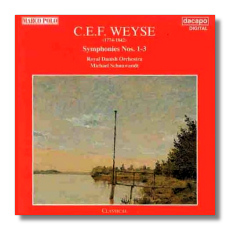
The Internet's Premier Classical Music Source
Related Links
- Latest Reviews
- More Reviews
-
By Composer
-
Collections
DVD & Blu-ray
Books
Concert Reviews
Articles/Interviews
Software
Audio
Search Amazon
Recommended Links
Site News
 CD Review
CD Review
Christoph Ernst Friedrich Weyse

- Symphony #1 in G minor, DF 117 (1805)
- Symphony #2 in C Major, DF 118 (1797)
- Symphony #3 in D Major, DF 119 (1800)
Royal Danish Orchestra/Michael Schønwandt
Marco Polo da capo 8.224012 - 67min
I recently read that scholars are beginning to doubt whether Marco Polo ever really visited China. Whatever the truth of the matter, the record company that bears the explorer's name continues to uncover some of the most fascinating byways in the world of classical music. Their latest excursion takes us to Denmark for the first three symphonies by Christoph Ernst Friedrich Weyse (1774-1842).
The composer's birthplace, Atlona, is now part of Germany, though in Weyse's time it belonged to the Danish monarchy. At age 15 he left home to study music in Copenhagen, and he remained there for the rest of his life. He first achieved fame in the 1790s for his performances of Mozart's piano concertos. Subsequently, he served as both a church organist and court composer. He soon became known for the quality of his sacred works and 'singspiels'. In later years, Schumann expressed admiration for at least some of Weyse's piano music, and both Weber and Liszt felt compelled to journey to Denmark in order to meet this remarkable composer.
The New Grove contends that Weyse's seven symphonies are "not of real importance as independent concert music". Perhaps, though there *is* much worthwhile music here. Weyse composed all of his symphonies in a brief burst of creativity just before the dawn of the 19th century (1795-99). Perhaps it was the appearance of Beethoven's First Symphony the following year that caused Weyse to turn his attention to forms of musical expression where the competition was not as stiff. Whatever the case, Grove notes that the arch-conservative Weyse "scarcely adapted to the new trends in Beethoven's works." The three symphonies recorded here, however, reveal a talented composer standing at the crossroads between two remarkable centuries. If these scores owe a considerable debt to Haydn and Mozart in terms of their structure and rhetoric, they simultaneously look forward to Schubert, Beethoven, and even Felix Mendelssohn.
Weyse's First, like Mozart's 40th, is in G minor. And while Mozart's influence is never very far from surface, Weyse also displays a distinct personality of his own. The scoring here – and indeed in all the symphonies on this disc – is especially inventive. Weyse often relies upon the winds and brass to advance the symphonic argument, particularly in the stormy, Beethovenian development section of the Symphony's opening movement, which is quite daring for a work composed in 1795. Meanwhile, the lovely trio of II (minuet) could easily be mistaken for early Schubert owing to its fluid grace, winning lyricism, and warm woodwind colors. The spirited finale combines the severity of Mozart with a welcome foretaste of the corresponding movement from Mendelssohn's Italian Symphony.
There's a gruff, Beethovenian edge to Weyse's Second Symphony, though conductor Schønwandt unfortunately smooths over nearly all the rough edges. This work is also notable for its melodic invention, the concise and imaginative development of its material, and, again, the kaleidoscopic scoring. In the last regard, this Symphony represents a considerable advance over its predecessor. In the First Symphony, Weyse was too often content to allow the strings to present one theme, then have the winds introduce the next. In this work the winds are more fully integrated into the score's rich textures. Schønwandt, alas, allows the strings to dominate, even when the winds should have center stage. The variations in II are both appealing and forward-looking. Only the monotonous trio of III and the routine development in the finale disappoint.
Symphony 3 is more traditionally classical in style, which leads me to suspect that it may, in fact, have been the first in order of composition. I is clearly reminiscent of Haydn, while II recalls the entrance of the statue in Mozart's Don Giovanni – albeit minus Mozart's inspiration. The thematic material is generally weak, though III boasts a delightfully spooky trio, and the witty finale grabs your attention right from the start with an unexpected oboe solo. A more inspired interpreter could surely make a stronger case for this charming little symphony.
Weyse often exhorts his interpreters to play "con brio" or "con spirito". Maestro Schønwandt invariably ignores these instructions. And he reduces much of the composer's brilliant scoring to bland grayness. Exposition repeats have all been eliminated – possibly in order to fit these three symphonies on a single disc. I'm hardly a fanatic about repeats, but given that this music is almost totally unknown, they ought to have been included. The sound is murky and distant, as if the orchestra were partially obscured behind a thick sonic veil. Still, if you want to hear this often astounding music, there is – for the moment at least – no alternative.
Copyright © 1997, Tom Godell


















